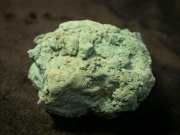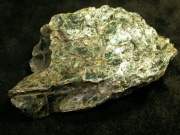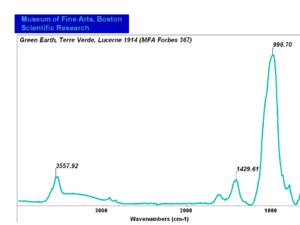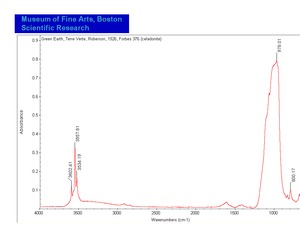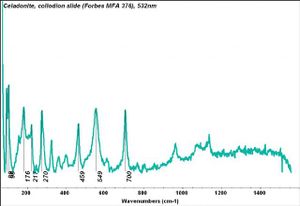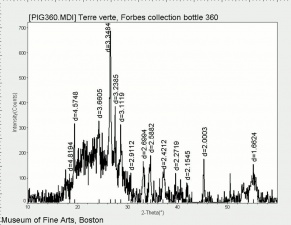Difference between revisions of "Green earth"
| (One intermediate revision by the same user not shown) | |||
| Line 2: | Line 2: | ||
== Description == | == Description == | ||
[[File:pc30231chlorite.jpg|thumb|Chlorite]] | [[File:pc30231chlorite.jpg|thumb|Chlorite]] | ||
| − | Green colored siliceous, iron-rich clays that have been used as pigments since ancient times. Green earth pigments were ground from available minerals, principally [[celadonite]] and [[glauconite]], though cronstedtite, [[montmorillonite]], and [[chlorite]] have also been used. The color of green earth can range from yellow-green to sea-green to greenish-gray. In general, green earth is translucent in oils with moderate tinting strength and poor hiding power. It is a permanent, stable pigment that is compatible with all media. Green earth, | + | Green colored siliceous, iron-rich clays that have been used as pigments since ancient times. Green earth pigments were ground from available minerals, principally [[celadonite]] and [[glauconite]], though cronstedtite, [[montmorillonite]], and [[chlorite]] have also been used. The color of green earth can range from yellow-green to sea-green to greenish-gray. In general, green earth is translucent in oils with moderate tinting strength and poor hiding power. It is a permanent, stable pigment that is compatible with all media. Green earth pigments were widely used in Roman wall paintings as well as Argentinian rock art, Chumash rock art in California, and Buddhist frescos in India (Siddall 2018). |
| + | Green earth, or terre verte, is sometimes imitated by mixtures of [[Naples yellow]] and [[Prussian blue]]. | ||
| + | [[[SliderGallery rightalign|Green Earth, Terre Verde, Forbes 367.PNG~FTIR Forbes367 (MFA)|Green earth, Terre verte, Roberson, 1926 (bottle 376- celadonite)).TIF~FTIR Forbes376 (MFA)|ChartImageLarge_2690.jpg~Raman (MFA)|PIG360.jpg~XRD|f360sem.jpg~SEM|f360edsbw.jpg~EDS]]] | ||
== Synonyms and Related Terms == | == Synonyms and Related Terms == | ||
Pigment Green 23; CI 77009; terre verte (Fr.); terra verde (It., Port.); tierra verde (Esp.); grüne Erde (Deut.); creta viridis; celadon green; Veronese earth; Belgian earth; Hessian earth; Tyrolean earth; Bohemian earth; Saxon earth; Rhenish earth; green stone; Theodotion; prasina; holly green; verdetta; aegirin; celadonite: glauconite: cronstedtite; chlorite | Pigment Green 23; CI 77009; terre verte (Fr.); terra verde (It., Port.); tierra verde (Esp.); grüne Erde (Deut.); creta viridis; celadon green; Veronese earth; Belgian earth; Hessian earth; Tyrolean earth; Bohemian earth; Saxon earth; Rhenish earth; green stone; Theodotion; prasina; holly green; verdetta; aegirin; celadonite: glauconite: cronstedtite; chlorite | ||
| − | |||
| − | |||
== Risks == | == Risks == | ||
| − | |||
* No significant hazards. | * No significant hazards. | ||
* Some forms of celadonite have fibrous needle-like crystals. | * Some forms of celadonite have fibrous needle-like crystals. | ||
== Physical and Chemical Properties == | == Physical and Chemical Properties == | ||
| − | + | * Slightly soluble in acids. | |
| − | Slightly soluble in acids. Turns a warm, dark-brown color (known as burnt green earth) when heated to around 500 °C. | + | * Turns a warm, dark-brown color (known as burnt green earth) when heated to around 500 °C. |
| − | + | * Density = 2.5-2.7 g/ml | |
| − | + | * Refractive Index = 1.62 | |
| − | |||
| − | |||
| − | |||
| − | |||
| − | |||
| − | |||
| − | |||
== Additional Images == | == Additional Images == | ||
| − | |||
<gallery> | <gallery> | ||
File:celadonite C100x.jpg|Celadonite | File:celadonite C100x.jpg|Celadonite | ||
Latest revision as of 13:03, 28 February 2024
Description
Green colored siliceous, iron-rich clays that have been used as pigments since ancient times. Green earth pigments were ground from available minerals, principally Celadonite and Glauconite, though cronstedtite, Montmorillonite, and Chlorite have also been used. The color of green earth can range from yellow-green to sea-green to greenish-gray. In general, green earth is translucent in oils with moderate tinting strength and poor hiding power. It is a permanent, stable pigment that is compatible with all media. Green earth pigments were widely used in Roman wall paintings as well as Argentinian rock art, Chumash rock art in California, and Buddhist frescos in India (Siddall 2018).
Green earth, or terre verte, is sometimes imitated by mixtures of Naples yellow and Prussian blue.
Synonyms and Related Terms
Pigment Green 23; CI 77009; terre verte (Fr.); terra verde (It., Port.); tierra verde (Esp.); grüne Erde (Deut.); creta viridis; celadon green; Veronese earth; Belgian earth; Hessian earth; Tyrolean earth; Bohemian earth; Saxon earth; Rhenish earth; green stone; Theodotion; prasina; holly green; verdetta; aegirin; celadonite: glauconite: cronstedtite; chlorite
Risks
- No significant hazards.
- Some forms of celadonite have fibrous needle-like crystals.
Physical and Chemical Properties
- Slightly soluble in acids.
- Turns a warm, dark-brown color (known as burnt green earth) when heated to around 500 °C.
- Density = 2.5-2.7 g/ml
- Refractive Index = 1.62
Additional Images
Resources and Citations
- Ruth Siddall, 'Mineral Pigments in Archaeology: Their Analysis and the Range of Available Materials' Minerals Vol 8, p. 201 (2018). Link
- R. J. Gettens, G.L. Stout, Painting Materials, A Short Encyclopaedia, Dover Publications, New York, 1966 Comment: density= 2.5-2.7 and ref.index = 1.62
- C. Grissom, "Green Earth", Artists Pigments, Volume 1, R. Feller (ed.); Cambridge University Press: Cambridge, 1986.
- Ralph Mayer, A Dictionary of Art Terms and Techniques, Harper and Row Publishers, New York, 1969 (also 1945 printing)
- Helen Howard, Contributed information, November 2007
- The Dictionary of Art, Grove's Dictionaries Inc., New York, 1996 Comment: "Pigment"
- M. Doerner, The Materials of the Artist, Harcourt, Brace & Co., 1934
- R.D. Harley, Artists' Pigments c. 1600-1835, Butterworth Scientific, London, 1982
- Matt Roberts, Don Etherington, Bookbinding and the Conservation of Books: a Dictionary of Descriptive Terminology, U.S. Government Printing Office, Washington DC, 1982
- Thomas B. Brill, Light Its Interaction with Art and Antiquities, Plenum Press, New York City, 1980 Comment: ref. index = 2.5-2.7 (seems like an error)
- Art and Architecture Thesaurus Online, https://www.getty.edu/research/tools/vocabulary/aat/, J. Paul Getty Trust, Los Angeles, 2000
- Pigments Through the Ages: http://webexhibits.org/pigments/indiv/overview/greenearth.html - alpha =1.59-1.612, beta =1.609-1.643, gamma =1.61-1.644 (Link to UV Vis spectra)
